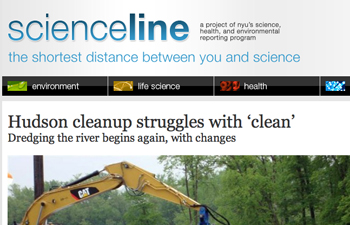I learned how to be a journalist at my college paper. I didn’t go to journalism school. But I teach at one, and from the time that I became an adjunct at New York University’s Science, Health, and Environmental Reporting Program (SHERP) in 2002, I would periodically think about how to recreate the experience of working at a college paper for a small group of graduate students learning how to do specialized journalism.
More and more outlets are looking for reporters and editors with expertise, whether it’s so they can hit the ground running when they’re hired, or curate more effectively. That’s certainly true at the magazines, websites, and broadcast outlets where SHERP graduates want to work, and at my own, a specialized health wire service.
So when SHERP Director Dan Fagin, who also learned how to be a journalist at his college paper, and I realized in 2005 that we were thinking along the same lines, we did some brainstorming. How could we create a site that gave students the opportunity to run a specialized news organization? We wanted a versatile, adaptable platform that would let students jump in and enjoy the rewards — and headaches — of online publishing.
We settled on WordPress, and hired a great designer. We included students from the beginning, letting them decide everything from content categories to color palette. And they came up with the name, too: Scienceline.
Since 2006, Scienceline has been the online magazine of science that’s written, edited and produced entirely by SHERP students, who call themselves “SHERPies.” They have published hard-hitting news, features, blogs, videos and podcasts, and encouraged interactivity through comments and polls. Students typically post new stories three times per week, in addition to blogs. Here’s a recent video on Scienceline about e-cigarettes:
E-Cigarettes in New York City from Scienceline on Vimeo.
A specialized sandbox
The site’s content is divided into four categories. In Physical Science, visitors find stories on everything from the fates of universes to how scientists helped resolve a dispute over a massive telescope. In Health, they’ll read about whether a walk in the park can replace a psychiatrist, and about research into using parasites to treat diseases.
In Environment, visitors can learn how a proposed road in the Serengeti is dividing people as it divides land, and about a scientist who, somewhat reluctantly, dropped everything to study the BP oil spill. And Life Science pieces explore what language says about the way we think, and how the state of Hawai’i used a natural predator to fight an invasive species, among other subjects.
All of those categories offer a rich selection of blogs, as well as audio, video and graphics.
The Scienceline staff — which is made up of SHERP students, usually 15 per year — plans every piece of content on the site, from pitching to editing to copyediting and posting. (I’m the faculty adviser, and Fagin is the publisher, but it’s the SHERPies who run Scienceline.) Some stories are written for class, while others go directly to Scienceline. They have rigorous standards for copy, including multiple layers of editing and a transparent corrections policy. They hold weekly meetings, and publish throughout the year, even during the summer.
Scienceline content is highly regarded, and is frequently republished in leading science journalism outlets including Scientific American, Discover, Popular Science and LiveScience. It’s on Scienceline itself, however, that students do what many news organizations are hoping to do: orchestrate a conversation around their content, whether it’s text, audio or video. Visitors can even ask questions that the staff answers with reporting, in the Ever Wondered column. Readers apparently like what they find on Scienceline, since on a typical day about 3,000 of them stop by for a visit. There have been 4 million visits since the site launched in mid-2006.
The pros like it too: Scienceline is a three-time Region 1 finalist in the Society of Professional Journalists’ Mark of Excellence Awards. Perhaps more importantly, students have tons of clips, which are attractively archived on the site, with each current and former student with his or her own author URL. Employers are impressed.
And so are Fagin and I. The site has been everything we imagined and more, allowing students to create rich, specialized content that shines. We learn something with every new Scienceline experiment, as the site changes with each class of SHERPies. It has recently been redesigned to improve the user experience and add various content types. And the students are even creating an iPad app.
We never know what’s next for Scienceline, but we do know it’s making SHERPies better prepared for an evolving job market — and that’s a big task.
Ivan Oransky, MD, is the executive editor of Reuters Health. He teaches medical journalism at New York University’s Science, Health, and Environmental Reporting Program, is the treasurer of the Association of Health Care Journalists, and blogs at Embargo Watch and Retraction Watch. He has also served as managing editor, online, of Scientific American, deputy editor of The Scientist, and editor-in-chief of the now-defunct Praxis Post. For three years, he taught in the health and medicine track at the City University of New York’s Graduate School of Journalism. Ivan earned his bachelor’s at Harvard, where he was executive editor of The Harvard Crimson, and his MD at the New York University of School of Medicine, where he holds an appointment as clinical assistant professor of medicine.

